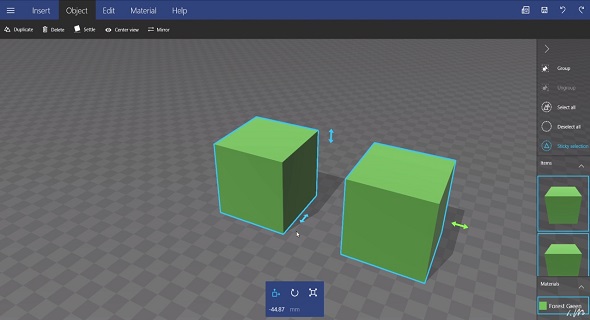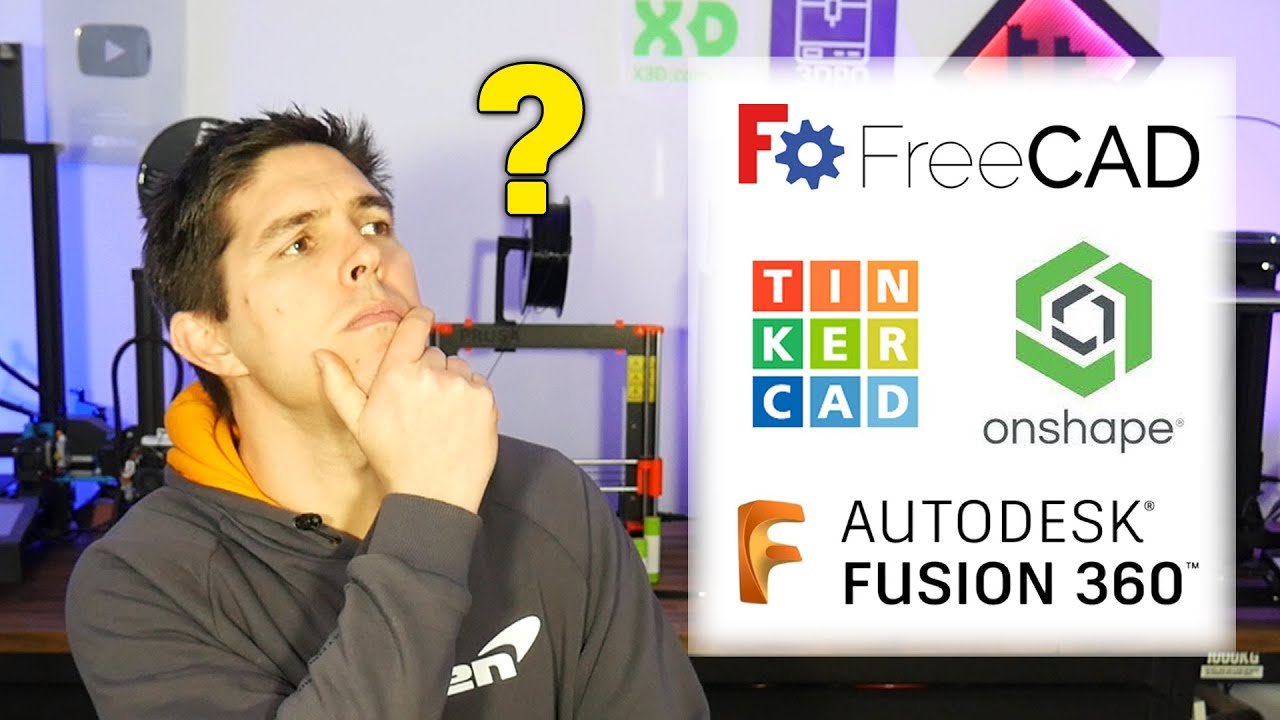Official Creality Ender 3 3D Printer Fully Open Source with Resume Printing Function DIY Printers Build Volulme 8.66x8.66x9.84 inch
$179.00 (as of June 19, 2025 23:45 GMT +00:00 - More infoProduct prices and availability are accurate as of the date/time indicated and are subject to change. Any price and availability information displayed on [relevant Amazon Site(s), as applicable] at the time of purchase will apply to the purchase of this product.)In the world of 3D printing, there are numerous software options available for creating models. In this video by InspirationTuts, the different 3D modeling and design software are categorized into three categories: beginner software, high-end professional software, and free professional software. For beginners, Tinkercad is recommended, while high-end professional users can opt for software like Creo and CATIA. Fusion 360 is a great choice for free professional use. Each software offers unique features and capabilities for creating 3D models suitable for 3D printing. The video also provides additional resources such as Blender addons and courses for further information.
While the video mainly focuses on modeling software, it’s important to note that slicing software is also crucial in the 3D printing process. Slicing software converts the 3D models into G-codes that can be read by 3D printers. Although high-end 3D printers often come with built-in slicing software, there are other options available. This article aims to guide you in choosing the right software for your 3D printing projects, whether you’re a beginner or a professional, by highlighting the features and benefits of different options.
Beginner Software
Tinkercad
Tinkercad is a simple and easy-to-use computer-aided design program that serves as a great introduction to 3D modeling and printing for beginners. It is a free browser-based software, which means that you can access and use it online without the need for any installation or downloads. Tinkercad offers a user-friendly interface and intuitive tools that allow you to create both simple and complex 3D models for printing. It is particularly suitable for people with no prior experience in CAD modeling and even children can easily grasp its functionalities. There are plenty of online tutorials and videos available that can help you learn and master Tinkercad in no time.
Sculptris
Sculptris is a specialized 3D sculpting software that focuses on creating organic forms, making it an excellent tool for beginners in digital sculpting and 3D printing. Sculptris allows you to manipulate virtual clay by pulling, pushing, pinching, and twisting, giving you the freedom to create intricate and detailed sculptures. It is designed to be easy to learn, even for individuals with no prior experience in digital art. You can start off your digital sculpting journey with Sculptris and then export your creations for 3D printing. Integration with 3D printing makes it even more accessible for beginners to bring their digital sculptures to life.
High-End Professional Software
Creo
Creo is one of the top software options for high-end professional use in 3D modeling and printing. Developed by PTC, Creo offers a comprehensive suite of computer-aided design (CAD) software specifically designed for product design and manufacturing. It provides advanced features and tools for solid modeling, such as parametric modeling, 2D orthographic views, simulations, technical illustration, and more. Creo is widely used in various industries, including automotive, aerospace, consumer products, and industrial machinery. It offers a powerful platform for engineers and designers to create precise and innovative 3D models. However, it is important to note that Creo comes with a cost and requires a license for extended usage.
CATIA
CATIA is another high-end professional software that is widely used in industries such as automotive, aerospace, and electronics. Developed by Dassault Systèmes, CATIA is a multi-platform CAD and computer-aided engineering (CAE) software suite. It is often referred to as the “Autodesk of mechanical engineers” due to its comprehensive capabilities in product design and engineering. CATIA allows for the creation of complex 3D models, as well as extensive analysis and simulations. It has become the standard tool for designing various objects, from vehicles to buildings to components. Similar to Creo, CATIA requires a license and is primarily targeted towards professionals in the industry.

Free Professional Software
Fusion 360
Fusion 360 is a highly versatile and widely used free professional software for 3D modeling and printing. It is particularly popular among students, makers, and small companies due to its affordability and powerful capabilities. Fusion 360 offers a range of applications, including product design, mechanical engineering, and industrial design. It provides features like parametric modeling, advanced simulation and analysis, cloud collaboration, and generative design. Fusion 360 has a user-friendly interface and a fast workflow, making it easy for users to create complex mechanical pieces. It is compatible with Windows and Mac operating systems, and it offers different licensing options, including a free version for personal and non-commercial use.
Onshape
Onshape is a web-based CAD software that utilizes cloud computing, making it a convenient and accessible option for professional-level users. As a cloud-based platform, Onshape allows users to access and work on their projects from anywhere, as long as they have an internet connection. It offers advanced features like version control, collaboration abilities, and real-time editing. Onshape is particularly useful for teams working on complex projects, as it enables seamless collaboration and ensures that everyone has access to the latest version of the design. Onshape provides a free version with all the same functionality as the professional version, making it an attractive choice for both individuals and businesses.
SketchUp
SketchUp is known for its ease of use and is a popular choice for 3D modeling and printing, especially among beginners and hobbyists. It offers a free version with limited features, as well as a paid version with additional functionalities. SketchUp uses a direct editing approach called “push and pull,” which allows users to easily create 3D models by manipulating surfaces and edges. It has a user-friendly interface and customizable palettes. SketchUp is primarily used for architectural and interior design purposes, but it can be adapted for a wide range of applications. While the free version is suitable for basic modeling, the paid versions offer more advanced tools and features.
OpenSCAD
OpenSCAD is a script-only based CAD software that allows users to specify geometric primitives and modify and combine them to create 3D models. Unlike traditional CAD software with a graphical user interface, OpenSCAD relies on a scripting language to define the models. This approach offers precise control over the design process and enables parametric modeling. OpenSCAD is particularly suitable for engineers and programmers who prefer a more technical approach to 3D modeling. It is widely used for creating mechanical parts, prototypes, and functional objects. OpenSCAD is free and open-source, making it accessible to a wide range of users.
FreeCAD
FreeCAD is a general-purpose parametric 3D modeler that is suitable for various engineering fields, including mechanical engineering and product design. It offers a range of advanced features for 3D modeling, such as parametric modeling, sketcher, robot simulation, and more. FreeCAD allows users to create complex designs and simulate their functionality. It also supports various file formats, making it compatible with other CAD software. FreeCAD is free and open-source, providing users with the flexibility to modify and customize the software to suit their specific needs. It is a powerful tool for professional use, especially for those in the engineering industry.
Blender
Blender is a versatile and free 3D software that is widely used for creating animated films, visual effects, 3D printed models, and video games. It offers a comprehensive set of tools and features for 3D modeling, including sculpting, rigging, animation, simulation, and rendering. Blender has a dedicated community of users and developers, which means that there are plenty of resources and tutorials available to help users learn and master the software. It is compatible with Windows, Mac, and Linux operating systems, making it accessible to a wide range of users. Blender is a powerful option for both professionals and hobbyists looking to explore the possibilities of 3D modeling and printing.
Features and Capabilities of Different Software
Tinkercad (Beginner Software)
Tinkercad offers an overview and ease of use that make it ideal for beginners in 3D modeling and printing. Its user-friendly interface and intuitive tools allow users to create 3D models easily. Tinkercad provides pre-designed geometric shapes that can be added together quickly, enabling users to build complex structures. It also allows for customizing parameters, giving users more control over the design process. Tinkercad is suitable for beginners with no prior experience in CAD modeling, and its simplicity makes it accessible to children as well.
Creo and CATIA (High-End Professional Software)
Creo and CATIA are high-end professional software options that offer advanced features and tools for 3D modeling and printing. Creo provides a comprehensive suite of CAD software for product design, including parametric modeling, 2D orthographic views, simulations, and technical illustration. CATIA, on the other hand, offers multi-platform CAD and CAE software for various industries, allowing for the design of complex objects such as vehicles and components. Both Creo and CATIA are widely used in industrial applications and require a license for extended usage.
Fusion 360, Onshape, SketchUp, OpenSCAD, FreeCAD, Blender (Free Professional Software)
Fusion 360, Onshape, SketchUp, OpenSCAD, FreeCAD, and Blender are all free professional software options that offer different features and capabilities for 3D modeling and printing. Fusion 360 is known for its affordability and powerful capabilities in creating complicated mechanical pieces. Onshape is a web-based software with version control and collaboration abilities, making it ideal for professional-level users. SketchUp is popular for its ease of use and customizable interface. OpenSCAD is a script-only based software that allows for precise control over the design process. FreeCAD is a parametric modeler suitable for mechanical and product design. Blender is a versatile software used for creating animated films, visual effects, and 3D printed models. Each software offers unique advantages and is targeted towards different users and industries.

Tinkercad
Overview and Ease of Use
Tinkercad is a beginner-friendly computer-aided design (CAD) software that offers an accessible introduction to 3D modeling and printing. It is a free, browser-based program that allows users to create 3D models online without the need for any installation or downloads. Tinkercad’s user interface is straightforward and intuitive, making it easy for beginners to navigate and understand. The software provides pre-designed shapes and tools that can be easily manipulated and combined to create 3D models. Tinkercad’s simplicity and ease of use make it an excellent choice for individuals with no prior experience in CAD modeling, including children.
Features and Tools for 3D Modeling
Tinkercad offers a range of features and tools that enable users to create 3D models for printing. The software provides pre-designed geometric shapes, such as cubes, cylinders, and spheres, that can be added together to build more complex structures. Tinkercad also allows for customization of parameters, such as size and position, giving users more control over the design process. The software supports precise measurements and alignment through its snap grid feature, ensuring accuracy in designing 3D models. Additionally, Tinkercad provides features for grouping objects, duplicating elements, and importing external models, allowing for more versatility and creativity in the design process.
Suitability for Beginners
Tinkercad is specifically designed for beginners in 3D modeling and printing, making it an ideal choice for individuals with no prior experience in CAD software. The software’s user-friendly interface and intuitive tools allow beginners to quickly grasp the basics of 3D modeling. Tinkercad’s pre-designed shapes and customizable parameters make it easy to create simple or more complex 3D models without the need for advanced technical skills. Furthermore, Tinkercad offers a wide range of online tutorials and resources that provide step-by-step guidance on how to use the software effectively. Overall, Tinkercad’s simplicity and suitability for beginners make it a valuable tool for anyone looking to enter the world of 3D modeling and printing.
Sculptris
Overview and Focus on Organic Forms
Sculptris is a specialized 3D sculpting software that places a strong emphasis on creating organic forms. Developed by Pixologic, the same company behind the popular ZBrush software, Sculptris is designed to provide a digital sculpting experience akin to working with clay. The software uses a virtual clay medium, allowing users to pull, push, pinch, and twist digital clay to shape their creations. Sculptris is particularly popular among artists and designers who are interested in creating characters, animals, monsters, and other organic shapes.
Ease of Use for Beginners
Sculptris is known for its ease of use, making it accessible to beginners in digital sculpting. The software provides a simplified interface with intuitive tools that mimic traditional sculpting techniques. Users can quickly learn to manipulate the virtual clay and create detailed sculptures without the need for extensive technical knowledge. Sculptris offers features such as dynamic tessellation, which automatically adds more detail to areas that require it, allowing for a smooth and responsive sculpting experience. The software also supports various brushes and alpha maps, enabling users to add intricate details and textures to their creations.
Integration with 3D Printing
Sculptris is not specifically designed for 3D printing, but it can be used in conjunction with other software to prepare models for printing. Once a sculpture is complete in Sculptris, it can be exported in various file formats, such as OBJ or STL, which are commonly used in 3D printing. Users can then bring the exported file into slicing software to prepare it for printing. While Sculptris does not offer extensive tools for optimization and preparation of 3D models for printing, it serves as an excellent starting point for beginners to explore the world of digital sculpting and 3D printing.

Creo and CATIA
Overview of High-End Professional Software
Creo and CATIA are two prominent examples of high-end professional software for 3D modeling and printing. Both Creo and CATIA offer extensive capabilities and features that cater to the needs of professionals in various industries. These software suites provide comprehensive solutions for product design, engineering, and manufacturing, enabling users to create complex and precise 3D models.
Advanced Features and Tools
Creo and CATIA incorporate advanced features and tools to support high-end professional use. Creo offers a range of CAD functionalities, such as parametric modeling, 2D orthographic views, simulations, technical illustration, and more. It provides a robust platform for engineers and designers to create innovative 3D models. CATIA, on the other hand, is a multi-platform CAD and CAE software suite that encompasses design, analysis, simulation, and manufacturing capabilities. It allows users to design various objects, from vehicles to buildings to components, and supports collaboration across teams during the design process.
Industries and Use Cases
Creo and CATIA are widely used in industries such as automotive, aerospace, consumer products, and industrial machinery. These software suites are specifically tailored to meet the needs of professionals in these industries, providing specialized tools and workflows. Creo, with its sophisticated parametric modeling capabilities, is well-suited for designers and engineers in product development and manufacturing. CATIA, as the cornerstone of the Dassault Systèmes product suite, has become the standard tool for many engineers and drafters, particularly in the automotive and aerospace sectors.
Cost and Licensing
Both Creo and CATIA require a license for extended usage and are primarily targeted towards professional users. The cost of these licenses can vary depending on the specific requirements and usage. Typically, high-end professional software like Creo and CATIA involves a significant investment, making them more suitable for established businesses and organizations with dedicated design and engineering departments. It is important to consider the cost and licensing factors when selecting a high-end professional software for 3D modeling and printing, as they can significantly impact the overall budget and resource allocation.
Fusion 360
Overview and Applications
Fusion 360 is a highly versatile free professional software that offers a range of applications for 3D modeling and printing. Developed by Autodesk, Fusion 360 provides a comprehensive suite of tools and features that cater to various design needs, including product design, mechanical engineering, and industrial design. It is widely used by students, makers, and small companies due to its affordability and powerful capabilities.
Affordability and Licensing Options
One of the key advantages of Fusion 360 is its affordability compared to other high-end CAD software. Fusion 360 offers different licensing options, including a free version for personal and non-commercial use. The free version provides access to most of the software’s features and functionalities, making it an attractive choice for individuals and small businesses with limited budgets. For those who require more advanced features or commercial usage, Fusion 360 also offers affordable pricing plans, making it accessible to a wider range of users.
Features for Creating Complicated Mechanical Pieces
Fusion 360 excels in creating complicated mechanical pieces, thanks to its powerful computer-aided manufacturing (CAM) suite. The software provides a range of features and tools for designing and manufacturing intricate mechanical components. Users can leverage Fusion 360’s parametric modeling capabilities, simulation and analysis tools, and advanced manufacturing workflows to create complex and precise 3D models for printing. Fusion 360’s capabilities in creating functional parts make it a valuable asset for engineers and designers working on mechanical projects.
Workflow and User-Friendliness
Fusion 360 offers a fast and efficient workflow, allowing users to streamline their design process. The software features a user-friendly interface with intuitive tools that promote productivity and collaboration. Fusion 360 supports cloud-based collaboration, enabling teams to work on projects simultaneously and access the latest version of the design in real-time. The software also provides built-in cloud storage and version control, ensuring that all project files are securely stored and accessible from any device with an internet connection. Fusion 360’s user-friendly workflow and collaborative features make it a popular choice among individuals and small teams alike.
Onshape
Introduction to Web-Based CAD Software
Onshape is a web-based computer-aided design (CAD) software that offers a modern and collaborative approach to 3D modeling and printing. Unlike traditional CAD software that requires installation on a specific device, Onshape utilizes cloud computing to provide a powerful and accessible platform for design and engineering.
Advantages of Cloud Computing
One of the key advantages of Onshape is its reliance on cloud computing. As a cloud-based program, Onshape allows users to access and work on their design projects from anywhere with an internet connection. This makes it particularly convenient for teams working on projects remotely or across different locations. Additionally, cloud computing frees users from the need to install and maintain software locally, reducing hardware and software compatibility issues. With cloud-based storage, users can securely store and manage their design files without relying on physical storage devices.
Version Control and Collaboration Abilities
Onshape offers advanced version control and collaboration features, making it an ideal choice for professional-level users and teams. The software automatically tracks and documents changes made to the design, allowing users to access previous versions and compare modifications. This ensures that everyone has access to the latest version of the design and eliminates the hassle of managing multiple files manually. Onshape also supports real-time collaboration, enabling multiple users to work on the same design simultaneously. This promotes efficient teamwork and streamlines the design process.
Targeted Users and Industries
Onshape is designed to cater to professional-level users and teams, particularly those who require version control and collaboration abilities in their design workflow. The software is suitable for various industries, including product development, mechanical engineering, and architecture. Onshape provides advanced 3D modeling capabilities, such as parametric modeling, assemblies, and drawings, in a user-friendly and cloud-based environment. Its targeted features and industry-specific tools make it an excellent choice for companies and design teams looking for a modern CAD solution.
Conclusion
Choosing the right 3D printing software requires careful consideration of your skill level and specific requirements. Whether you are a beginner looking for a user-friendly software or a professional in need of advanced tools, there are options available to meet your needs.
For beginners, Tinkercad and Sculptris offer accessible and easy-to-use platforms for learning and experimenting with 3D modeling and printing. Tinkercad’s simplicity and pre-designed shapes make it ideal for beginners, while Sculptris focuses on organic forms and digital sculpting.
For high-end professional use, Creo and CATIA are powerful software options that provide advanced features and tools for complex 3D modeling. These software suites are widely used in industries like automotive and aerospace and cater to the needs of professionals in those fields.
Free professional software like Fusion 360, Onshape, SketchUp, OpenSCAD, FreeCAD, and Blender offer a range of features and capabilities for various applications. Fusion 360 stands out for its affordability and powerful capabilities in creating complicated mechanical pieces. Onshape, as a web-based CAD software, provides collaboration and version control abilities. SketchUp is known for its ease of use and customizable interface. OpenSCAD offers a script-only approach for precise control over the design process. FreeCAD is a flexible parametric modeler suitable for mechanical engineering and other applications. Blender offers versatility across various domains, including film, visual effects, and 3D printing.
Consider matching the software to your skill level, requirements, and industry. Explore additional resources and tutorials specific to the software to enhance your knowledge and skills. With the right 3D printing software, you can unlock your creativity and bring your ideas to life through the exciting world of 3D modeling and printing.
If you’re wondering what 3D printing software to use, there are a lot of options available. In this video, we’re going to categorize these software into three different categories: beginner-friendly options for those with no experience, high-end professional software, and free professional software.
Check out these amazing Blender Addons:
Modeling:
- Kit Ops 2 Pro: Link
- Hard Ops: Link
- Fluent: Link
- Box cutter: Link
- Mesh Machine: Link
- Cablerator: Link
- shipwright: Link
Architecture/Rendering:
- CityBuilder 3D: Link
- scatter: Link
- Botaniq Tree Addon: Link
- Sketch Style: Link
- E-Cycles: Link
- K-cycles: Link
- Grasswald: Link
- Photographer: Link
VFX, Simulations & Dynamics:
Materials/Texturing:
Cloth Simulation:
- Simply Cloth: Link
UV unwrapping:
Rigging & Animation:
Retopology:
- Retopoflow: Link
For more information and additional resources, check out the inspirationTuts website and their YouTube channels: inspirationTuts 2D Channel and inspirationTuts CAD Channel.
You can also explore their amazing courses that cover various aspects of 3D design and modeling. Here are some recommended courses:
- A-Z Environment Design using Trim Sheets: Link
- SciFi Weapon Design in Blender – REMASTERED: Link
- SciFi Mech Design in Blender: Link
- The ULTIMATE Guide to Hard Ops and Boxcutter: Link
- The BlenderBros Hard Surface Game Asset Course: Link
- Essential Techniques for UV Unwrapping in Blender: Link
- NITROX3D Full Course: Link
Please note that some of the links provided are affiliate links that help support the creation of more content. Thank you in advance for considering to use these links!











